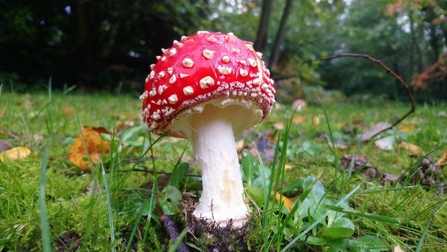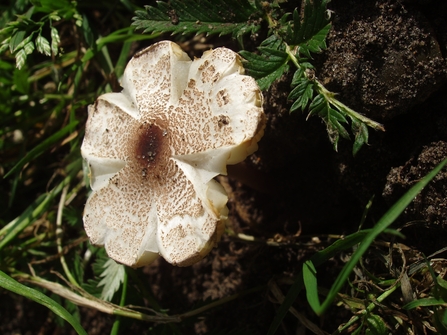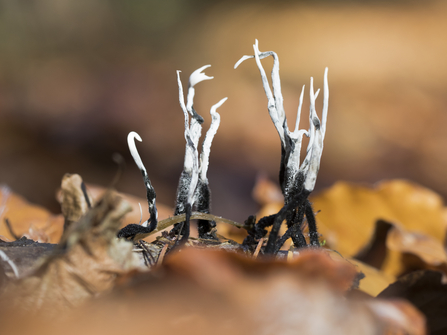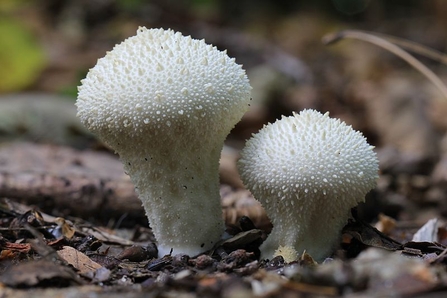As summer passes in London, winds cool, drizzly showers pick up and nights begin to draw in. Nuts and berries ripen, wrinkle, and drop, and our streets become carpeted in rusting, rustling leaves. Autumn, the season of senescence and decay, witnesses a dulling of the senses as colours fade to brown, and flowers and butterflies disappear. But there is one final flourish, one last outburst. A display of reds, pinks, purples, whites, yellows and chestnut browns arise from the ground - the 'fruits' of toadstools, mushrooms, and other fungi bring a chorus of beauty before the curtain of another year draws to. And this occurs in London as much as it does elsewhere in the country, but with a difference their locations are frequently more idiosyncratic, more unexpected than elsewhere, and rare species are given opportunities it would be hard to engineer. One does not need to venture into the countryside to enter the often-mysterious world of mushrooms and toadstools.

The fungi of London are largely hidden gems, known only to the keenest mycologists. Autumn's guided fungal forays are popular events because only an experienced eye will know exactly where to find that fine ring of extraordinary earthstars Geastrum triplex in Holland Park or the rare Pholiota jahnii in Abney Park Cemetery, Stoke Newington. How many of us would guess that it's worth turning over a piece of old carpet fly-tipped in Dulwich Upper Wood (or abandoned copies of Yellow Pages (1) in Peckham Rye Park) to find the undulating cups of Peziza repanda?
Like invertebrates, the more one looks for fungi the more one generally finds. Our understanding and study of them though, is primitive compared with that of vascular plants and birds. This is partly why there is nowhere in London that enjoys any official or special protection because of its fungal diversity. Perivale Wood in Ealing lost its Site of Special Scientific Interest (SSSI) status when it was declared a Local Nature Reserve in 1974, even though it has been specifically recommended for its fungi records.(2)

Earthstar fungus
Photo credit: Tim Webb
The fruiting of fungi, in all their myriad forms, is not confined to autumn. Many can be found throughout the year, but they come into their own between September and November. Hidden for much of the year as a dense network of hair-thin strands (mycelia) below the soil, or underneath the bark of dead and living trees, the early autumn rains stimulate the production of their fruiting bodies - the sporophore - which bring them to our attention. We are all familiar with the classic umbrella shapes of toadstools - whether slender mycenae and blewits, sturdy and erect agarics and russulas, or thick and bulbous as in the boletes. More outlandish are the saucer-shaped ones (polypores), the near-spherical (puffballs and King Alfred's cakes), the ear-shaped (hare's-ear, jelly-ear), the sponge-like, those that appear as a frozen flow of gelatinous liquid (oyster, chicken-of-the-woods, chanterelle), the vulgar (stinkhorn) or the simply alien (earthstars, candle-snuff and dead-man's fingers). No less magical are the smaller coral-spots, rusts and soots which spatter bark and leaves.

Candle-snuff fungus
Photo credit: Chris Lawrence
Fungi are saprophytes, which means that they obtain their nutrients from outside their bodies. They cannot photosynthesise and must obtain energy through the external breakdown of plant (and/or animal) material by the secretion of enzymes into their surroundings, reabsorbing the nutrients. The fungal body is rarely seen. Known as the mycelium, it is a network of fine strands (mycelia or hyphae) - which grows vegetatively. Sporophores, the fruit that you see above ground, are produced to disperse the millions of microscopic spores (the 'seeds'). These are dispersed by a variety of means - a gust of wind on the underside of the typical umbrella of a toadstool, ejected through a single pore during rain, manual pressure as in puffballs, or direct removal by animals as in stinkhorn. The spores will form the base for a new fungus if conditions are right.
As agents of disease, decay and death, fungi often get a bad press. But this role is an important one in providing that essential link in the chain that turns once-living matter into the essential nutrients and minerals for new life. They are also known to perform a function which is vital to terrestrial ecosystems - through the mutually beneficial relationship of fungi and the roots of grasses, plants, and trees. This helps the transfer of minerals from the surrounding soil to roots. It is believed that a woodland soil, for example, will be criss-crossed with a vast microscopic network of fungal strands (many tens of kilometres per hectare) partaking in this work. Plants planted without their associated fungi do not survive as well as those that are. Without it, trees and other plants suffer - and the application of chemicals through herbicides, pesticides, and sterilisation of soils all contribute to this subterranean damage.

Common puffball
Photograph by Stu's Images, distributed under a CC-BY 2.0 license.
In turn fungi form the food for many animals, often using particular means to attract them. The stinkhorn's sporophore is covered with a slimy jelly stinking of dead meat. This attracts flies which carry off the spores packed within the jelly. Other insects, especially small beetles, flies, and wasps eat fungi, and molluscs, small mammals and even birds join the feast. Fungi are also an essential part of lichens. Although most trees are able to live in equilibrium with their fungi, some are pathogenic. Honey fungus, often associated with beech, is a killer, and perhaps the most tragic of pathogens is Ceratostomella ulmi (3) - Dutch Elm Disease - a virulent fungus carried by a small beetle, whose spread has altered our landscape since the 1960s.(4) Many fungi are declining from a number of threats. Pollution and acid rain are blamed, particularly in the south-east.Heavily manicured green spaces where fungicides and chemicals are used are also culprits, as are some park managers who burn and chip dead trees instead of allowing them to rot, thus denying a valuable habitat which is also vital to other species such as stag beetle.
Honey fungus
Photo credit: Les Binns
Trampling by armies of pickers rather than the picking of fungi itself is believed to take its toll, and one expert warns that restaurants that pick everything in sight for sorting later should be discouraged. They say the precautionary principle should apply because we don't know enough about the harm caused by intensive harvesting. It's worth remembering that the sporophores which are collected are the 'fruit' of the fungus, and only in extreme cases is picking likely to harm them. Television chef Antonio Carluccio defends picking: "It's the biggest nonsense to stop it" he says. "If that's the reason they're disappearing, then we'd no more in Italy or where they've been picked for centuries. The reason they're disappearing pollution because the poisonous ones are disappearing too."(5)
Gathering fungi has probably declined compared to past centuries when fungi would have formed a major part of a freely available harvest - the recent interest through TV programmes and books has only reawakened a dormant part of our dietary culture (6). Car drivers are bad news for fungi eaters; fungi tend to absorb and accumulate pollutants within their tissues. Brown roll-rim Paxillus involutus, for example, used to be considered edible, but its tremendous ability to absorb toxic materials means it is now poisonous (7). Search, admire and marvel at them but beware: eating London's fungi is not advisable.
Mathew Frith, Director of Policy & Research
Postscript
This article is a slightly edited version of the original published in Wild London, autumn 1998. A few notes to update readers:
- Yellow Pages was a telephone directory of services and suppliers, first published in the UK in 1968, printed annually for each region and delivered to homes and businesses. Undelivered copies were often found dumped in nature reserves and other green spaces. The final printed edition was in 2019, its services replaced digitally by Yell.com.
- Perivale Wood, arguably the third oldest nature reserve in Britain, was considered for potential re-notification as a SSSI in the early 1990s. At that time about 500 species of fungi had been recorded there.
- Many fungi names have since changed; this is now known as Ophiostoma ulmi.
- Changes to our landscape are now occurring through ash dieback, caused by a fungus Hymenoscyphus fraxineus, originally from Asia, but first recorded in Britain in 2012 and is estimated to eventually kill 80% of the ash population here. Ironically, the spread of ash over the past 50 years has partly been to its ability to exploit the gaps left by the loss of elms.
- At the time a high-profile chef, Antonio Carluccio opened his first restaurant in 1999, spawning a popular chain over the following 15 years but which eventually went into administration in 2020 as a victim of Covid. Antonio Carluccio died in 2017.
- The interest in foraging for wild fungi began to take off in the mid-2000s, and by 2010-12 had become a problem in many sites in London and elsewhere across the country. Some landowners have imposed strict picking rules, partly confounded by complex and arcane legislation. London Wildlife Trust’s Foraging on Nature Reserves Policy aims to focus people on appreciation rather than collecting.
- Brown roll-rim in some circumstances is deadly poisonous.
